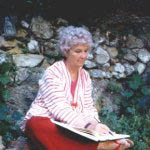Topics

You can buy a physical copy of Ann's book Satisfy the Image, from Handprint Press here.
Ann used Milton Erickson's common-sense and self hypnosis approach to dreams. She used art, dreams, and closed eye visioning in workshop intensives here and abroad. She taught at Lesley College Arts Institute, where she helped develop the Expressive Therapies Program, trained teachers, and earned her Master’s degree. Ann kept dream journals for fifty years, published two books on dreams, and was an ASD member and presenter for over 20 years, offering workshops and slide talks at IASD (almost every year), and at California’s Esalen Institute, The Cambridge center for Adult Education, and organizations here and abroad. She derived much inspiration from the work of Patricia Garfield, Freud, Jung, Milton Erickson, Gibran, the I Ching, the Dalai Lama, and others.
This adaptation of her Introduction to her last book, Satisfy the Image, summarizes her work:
Autodrama on the Paper Stage is a concrete mapping method that works for dreams and all kinds of life problems. You create your own symbols to represent the people and things in your story and set them on a sheet of paper we call the stage. Instead of telling the story in words, we use colored paper or found objects to represent characters and significant objects—it’s very simple. As you answer questions about the scene, you begin to understand the problem and manipulate the characters in search of resolution.
As a mini psychodrama, it shrinks the stage to a sheet of paper, eliminates other players, and offers a quick, direct approach. Working alone or with a guide, the dreamer plays all the roles, speaks and hears the dialogue, harvests projections, and negotiates a resolution.
The method came to me in a dream where I saw myself as a tiny human attached to the earth’s globe by gravity. Up in the universal darkness, a giant megaphone shouted “FIND THE IMAGE AND SATISFY IT.” Immediately I understood that the way to resolution was through the image, and the way to the image was through your feelings.
Since the age of three, I drew, painted, designed textiles, perfected and taught various crafts. When I had kids, I made bread sculpture, rag tapestries, furniture, and toys, and then turned it into how-to books. In the 1970’s, as Program Director for the Boston Children’s Museum Visitor Center, I developed how-to workshops so visitors could make paper, build looms and kites, and invent musical instruments from junk. I also conducted workshops for the New Hampshire elementary school system: sixty to ninety teachers came once a week for five-hour sessions on “Methods and Materials” and “Creative Enrichment.” We called it “Kindergarten for creatively deprived adults,” who were then very excited to take the ideas and methods back to their classes.
From there it was a short step to Expressive Therapy, a field just being defined at Lesley College. In addition to teaching there, I designed and completed my own Masters program based on work I did with teachers all over the country and in India.
Dreams were an arrow leading straight to the unconscious. Like parables, they provide perspective on truths too close to see. Visual methods make problem solving exciting because they require you to think outside the box and use all kinds of intelligence and sources of wisdom. Impatient with the time required by conventional dream work, I asked students to “show me your dream. Show me your problem. Create images. Make characters from torn tissue papers or find an object to represent people and things. Set the stage and tell the story on a sheet of paper.”
In half an hour, everyone in a class could create a scene and begin to work using ten simple questions. I just walked around the room helping to move things as needed. And there was the magic of working in groups. People borrowed from each other, saw what others were doing, heard the first solutions, and were inspired to take risks or reach out. Originality was rampant. Everyone left the room with new information, and often with a new resolution.
A Harvard student who took a workshop said, “This work you do is more interesting than all my psychology courses. I’d like my professor to see.” I did a workshop there, but the professor asked what books I was using, what theory?
“No books, no theory—just common sense and the wisdom of the dream, the power of peoples’ images. We simply ‘satisfy the image.’”
“Well, that isn’t going to make much sense to Academe is it?” he says.
“No. I guess not. It is not a theory; it is an experience.”
So you are the system. You are the method. It’s the doing that heals, creates change, and enlightens. When you experience it, you know it. It is the “Aha!” method.